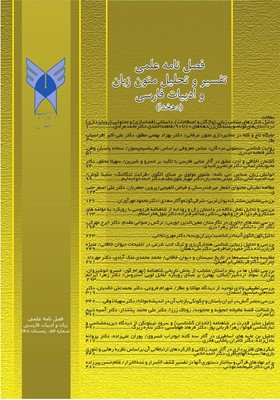خوانش زبان صناعی «نی نامه» مثنوی مولوی بر مبنای الگوی «قرائت تنگاتنگ» سلینا کوش
محورهای موضوعی : متون زبان و ادبیات فارسی
عبدالحمید امانی
1
,
عبّاس محمدیان
2
*
,
مهیار علوی مقدم
3
![]() ,
احمد خواجه ایم
4
,
احمد خواجه ایم
4
1 - دانشجوی دکتری زبان و ادبیات فارسی، دانشگاه حکیم سبزواری، سبزوار، ایران.
2 - دانشیار زبان و ادبیّات فارسی، دانشگاه حکیم سبزواری، سبزوار، ایران.
3 - دانشیار زبان و ادبیات فارسی، دانشگاه حکیم سبزواری، سبزوار، ایران.
4 - استادیار زبان و ادبیّات فارسی، دانشگاه حکیم سبزواری، سبزوار، ایران.
کلید واژه: مثنوی, «نینامه», الگوی قرائت تنگاتنگ, خوانش زبان صناعی, سلینا کوش,
چکیده مقاله :
هدف این پژوهش، خوانش زبان صناعی نی نامه مثنوی مولوی بر مبنای الگوی قرائت تنگاتنگ سلینا کوش است. رویکردی که افزون بر تفسیر جزئیات زبانی و روابط متقابل آن ها، تحلیل متغیّرهای دیگری همچون بافتار، بینامتنیت، روایت و ژانر متن را نیز ضروری می شمارد. این مقاله، به شیوۀ توصیفی- تحلیلی می کوشد به این پرسشها پاسخ دهد که راهبرد شاعر در به کارگیری زبان صناعی در نی نامه مثنوی چیست؟ و کارکرد هریک از صناعات در تحقّق اهداف این متن و انسجام کلّی آن چگونه است؟ نتایج نشان می دهد که صناعات به کار رفته در نی نامه طی یک فرایند منسجم، در دو گروه کلّی جای می گیرند:1) مرتبط با بشنو؛ 2) مرتبط با نی. گروه نخست با افزایش موسیقی کلام، مخاطب را به شنیدن ترغیب می کند؛ اصل وحدت در کثرت و فناپذیری جهان اضداد را به نمایش می گذارد و گروه دوم، جلوه هایی از از خودتهیشدن، هرولۀ روح آدمی برای رهایی از قفس تن، مجازی بودن دنیای ما، غیر قابل درک بودن عشق و غیره را.
The aim of this study is to read the figurative language of Mathnavi Mowlavi's "Neynameh" based on Celena Kusch's "close reading" method. An approach that in addition to interpreting linguistic details and their interrelationships also requires the analysis of other variables such as context, intertextuality, narrative and text genre. This article tries to answer these questions in a descriptive-analytical way. What is the poet's strategy in using figurative language in Mathnavi's "Neynameh"? What is the function of each figurative in achieving the goals of this text and its overall coherence? The results prove that the figures used in Neynameh fall into two general groups during a coherent process: 1) related to "Beshnow"; 2) related to "Ney"; the first group, with increasing music, urges the audience to "listen"; demonstrates the principle of unity in plurality; and the second group, manifestations of self- empty, the struggle of the soul for freedom from the cage, the virtual of our world; The being incomprehensible of love and so on.

